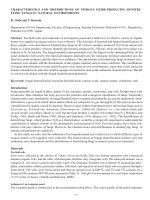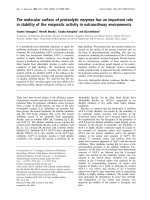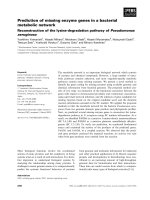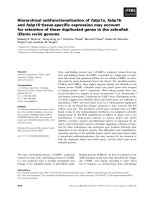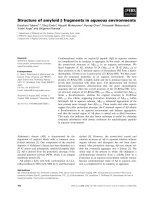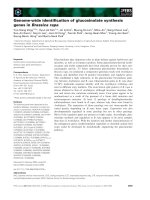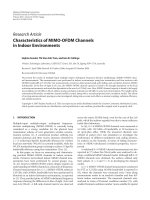Recovery of antibiotic resistance genes in natural environments
Bạn đang xem bản rút gọn của tài liệu. Xem và tải ngay bản đầy đủ của tài liệu tại đây (960.33 KB, 15 trang )
1
Recovery of antibiotic
resistance genes in natural
environments
by
MAI Thi Ngoc Lan Thanh
Submitted for the degree of
Master of Biotechnology
In
“Genomes, Cells, Development and Evolution”
M2 specialty: Genetics, Molecular Biology of Microorganisms and Genomics
Parcours: Biotechnology
Université Paris-Sud 11
Faculté des Sciences d’Orsay
Supervisor: Dr. LE Phi Nga
Head of Department of Biochemistry, University of Science
227 Nguyen Van Cu street, Ho Chi Minh city
July-2011
2
Content
Page
Content…………………………………………………………………………………………2
Acknowledgments……………………………………………………………………………..3
List of abbreviations…………………………………………………………………………...4
1.
2.
3.
4.
5.
6.
7.
Abstract…………………………………………………………………………....5
Introduction………………………………………………………………………..5
Experimental procedure …………………………………………………………..6
Results……………………………………………………………………………..8
Discussion ………………………………………………………………………...12
Conlusion………………………………………………………………………….12
References…………………………………………………………………………12
3
Acknowledgments
I wish to thank all people who made this work possible.
To Dr. LE Phi Nga for her support and guidance during my research at Department of
Biochemistry, University of Science- HCM. I have learned a lot and had much lab experiences
there.
To Msc. Vo Mai Tram for guiding me in the experimental practice and to every member of
Department of Biochemistry, University of Science-HCM, for their advices and helps .
I would also like to thank all professors who given me lectures and thanks to Professor Cécile
Pastenak for her kind support.
4
List of abbreviations
PCR
Polymerase chain reaction
DNA
Deoxyribonucleotide
CTAB
Cetyl trimethylammonium bromide
EDTA
Ethylenediaminetetraacetic acid
rpm
Rotations per minutes
SDS
Sodium Dodecyl Sulfate
TE
10 mM Tris –HCL, pH 8.0 and 1 mM EDTA
LB
Luria-Bertani
P:C:IAA
Phenol:Cloroform:isoamylalcohol
MIC
Minimum inhibitory concentration
5
Recovery of antibiotic resistance genes in natural
environments
1. Abstract:
Recently environmental metagenomics are useful methodology to study microbial
diversity in the environment as well as functional metabolic genes. This study was also
based on metagenomic method to discover antibiotic resistance genes from aquatic
environments. To create a metagenomic library, the environmental DNA was extracted
from water and sediment sample of Thi Nghe canal, Ho Chi Minh City. Total DNA then
was fragmented by sizes of 1-3 kb and inserted in to pUC19 plasmid. After
transformation into E.coli DH5 host, transfomants were screened by growth on a
minimal inhibition concentration (MIC) of antibiotics.
Results showed that antibiotic MIC values for Ecoli DH5pUC19 used as a negative
control are 5g/ml gentamicin, 6g/ml chloramphenicol, and 50g/ml streptomycin and
30g/ml tetracyclin. From a newly created environmental DNA library of 1.315 mega
bases (337 transformants) 176 clones resistant to gentamicin and 284 clones resistant to
chloramphenicol were found, but either recombinant resistant to streptomycin nor to
tetracycline.
Because of timing limited for a Msc. study, the sequences of clones have not been
verified yet. However, primarily results showed here indicate that the antibiotic resistant
gene(s) from an aquatic environment in HoChi Minh city could be cloned for further
studies.
Key words: environmental metagenomic, antibiotic resistance genes, uncultured
microorganism.
2. Introduction:
It has been estimated that less than 1% population of microorganisms in our earth are
cultivable, especially, only 0.1% known in marine environment [27]. Many useful
microorganisms have being used in the industry and environment. Microbes are powerful
bioconversion “machines” that play important roles in degradation of natural as well as
synthetic compounds including drugs or antibiotics, thus many of them are antibiotic
resistant.
6
Metagenomics, the genomic reconstruction from environmental samples can be a pool for
accessing the untapped resources of microbial biodiversity, which was larger than that
seen by traditional methodologies [9-12, 13-15]. Recently some functional genes such as
synthesis of biocatalysts, enzymes, antibiotic and antibiotic resistance genes have been
reported from metagenomic libraries.
Antibiotic resistance genes are generally cloned by a targeted PCR from a cultivable
microorganism. This method can not assess the major uncultivable population of
microorganisms that is believed to be more than 99% [4,5,6,7,8], thus novel antibiotic
resistance genes are still under recovered [1].
The polymerase chain reaction (PCR) can be used for culture-independent isolation
of antibiotic resistance genes from environmental samples [16-20]], but only accesses
genes that are similar to known sequences and often does not recover complete
genes. Here we circumvented the limitations of both culturing and PCR based methods
by extracting total DNA directly from environmental samples and cloning it, thus
constructing libraries include the genes of uncultured microorganisms[1]. Clones
expressing various enzymes reported previously [22][21][23] were from environmental
metagenomic libraries [21].
To construction of a metagenomic library, several vectors have being used such as
Fosmid vector [29], Cosmid [1], BCA vector [28], or plasmids [1] and the host can be E.coli
[28],[29],[1]
or Pseudomonas sp [30] depending on purposes. This study was based on
construction of a metagenomic library using plasmid pUC19 and host E.coli DH5. The
environment site for study is Thi Nghe bridge that belongs to Thi Nghe canal in Ho Chi
Minh city.
For screening antibiotic resistant E.coli strains bearing recombinant pUC19 plasmids,
4 common antibiotics such as gentamicin, tetracycline, chloramphenicol, streptomycin
were used.
3. Experimental procedure:
1. Materials and chemicals:
Wizard® SV Gel Kit and PCR Clean-Up System (Promega) were purchased from
Promega. Antibiotics were from HCMC Food Drug Quality Control Institute. Restriction
enzymes were products of Invitrogen. All other chemicals used were highest purity.
-
The E.coli strain DH5α (F ø80dlacZM15 (lacZYA-argF) U169 deoR recA1 endA1
hsdR17(r-k, m+k) phoA supE44 λ- thi-1 gyrA96 recA1) (Life Technologies) was used as
7
the host strain for maintaining libraries. Strains were grown in LB- medium with
100µg.ml-1 Amp and if it is necessary, an appropriate antibiotic was added.
2. Sampling and samples storage:
Each time, 5 litters of canal bottom water containing top-layer of sediment samples was
collected from Thi Nghe canal. Samples were immediately transferred to the laboratory
and centrifuged at 12,000 rpm 4oC for 10 min. Cell pellet was immediately under step of
extraction of total DNA or stored under – 80oC for later use.
3. Determination of MIC (Minimal Inhibition Concentration) of E.coli
DH5a/pUC19.
Minimum inhibitory concentrations (MICs) were determined using microtitre plate
dilution assays in LB broth with the various concentrations of each of 4 antibiotics. The
lowest concentration of antibiotic at which E.coli DH5/pUC19 does not growth is
defined as a MIC.
4. Extraction of total DNA from environmental samples.
Total DNA from pellet containing cells was extracted by manual protocol. In that
protocol, pellet (from about 1 liter sample) was re-suspended by 200µl solution (Tris-HCl
pH 8.0) and then 5.5µl protease K and 15µl 20% SDS added and mixture was incubated
for an hour at 37oC. After that 30 µl CTAB and 30 µl 5M NaCl were added and mixture
was further incubated at 65oC for an hour. The treated sample was extracted three times
with same volume of P:C:IAA mixture. Each time, after 10 min shaking by hands
mixture was centrifuged at 14,000 rpm for 5 minutes. The supernatant finally was
precipitated with 2.5 volume of ice-cold 96% ethanol and 1/10 volume per volume of 3M
CH3COONa, pH 4,5, and stayed at -20oC for 15-20 minutes. Total DNA pellet after
collected by centrifugation was air dried and re-suspended by 50 l TE buffer.
5. Construction of recombinant pUC19 caring inserted DNA fragment from
environment samples.
Total DNA was digested with 3 pairs of the restriction enzymes: HindIII - EcoRI;
HindIII - KpnI; or HindIII – BamHI, respectively. DNA fragments from 1- 3kb were cut
8
out and purified by kits and then inserted into the same restriction enzymes sites
(multicloning sites) of pUC19. The ligated mixture was transformed into E.coli DH5α
host cell and plated onto LB-Amp agar for numeration of tranformants. The table below
is the designs of ligation mixture.
Table-1: Insertion of the fragments into pUC19 vector:
tube
HindIII-EcoRI
HindIII-KpnI
HindIII-BamHI
DNA fragment
6µl
6µl
6µl
pUC19 vector
6µl
6µl
6µl
Ligation buffer 10X(with
ATP at 10mM)
2µl
2µl
2µl
H2O
6µl
6µl
6µl
T4 DNA ligase (3U/ml)
2µl
2µl
2µl
6. Screening transformants for antibiotic resistance clones.
Transformant were replicated on to LB-Amp and LB-Amp containing an additional
antibiotic with MIC:
50µg.ml-1 streptommycin, 30µg.ml-1 tetracycline, 5µg.ml-1
gentamycin or 6µg.ml-1 cloramphenicol, respectively. Plates were incubated overnight at
37oC. Positive clones were verified by growth in both types of plates and in construct
with the negative control of E.coli DH5/ pUC19 that can only grow in LB-Amp.
4. Results:
1. MIC values of E.coli DH5α/pUC19
The minimum inhibitory concentrations (MICs) of 4 antibiotics obtained on the E.coli
DH5α/pUC19 were various from 5- 50 g/ml depending on type of an antibiotics used.
The tables below are results of MICs determination with 4 antibiotics.
Table-2a: MIC of chloramphenicol:
Chloramphenicol
concentration (µg/ml)
Growth of DH5α/pUC19
(+) : growth,(-): no growth
1
2
3
4
5
6
7
8
9
10
11
12
+
+
+
+
+
-
-
-
-
-
-
-
9
table-2b: MIC of streptomycin:
Streptomycine
concentration (µg/ml)
Growth of DH5α/pUC19
10
15
20
25
30
35
40
45
50
55
60
65
+
+
+
+
+
-
-
-
-
-
-
-
(+) : growth,(-): no growth
table-2c: MIC of gentamicin:
Gentamicine
concentration (µg/ml)
Growth of DH5α/pUC19
1
5
+
-
(+) : growth,(-): no growth
table-2d: MICs of tetracycline:
Tetracycline concentration
(µg/ml)
Growth of DH5α/pUC19
5
10
30
+
+
-
(+) : growth,(-): no growth
MIC value of chloramphenicol is 6µg/ml, of streptomycin is 50µg/ml, of gentamicin is
5µg/ml, and of tetracycline is 30µg/ml.
2.
Creation of an environmental metagenomic
Figure-1: from left to right lanes, DNAs extracted from sediment (lane 1) and from water
(lanes 2 and 3). 2µl of 50 l of total DNA loaded per a lane.
The first step of making a metagenonic library from an environmental sample is
total DNA extraction. In figure-1, the concentration of DNA extracted from sediment
sample is higher and more smear band than that of DNA extracted from water sample.
This may indicate that DNA from sediment sample is more diverse thus it is better use for
purpose of mining a novel functional gene.
Environmental DNA extracted was digested by each pair of HindIII-EcoRI,
HindIII-KpnI, or HindIII-BamHI. The figure-2 shows environmental DNA fragments cut
by size 1-3 kb.
10
3kb
2.5kb
1kb
Figure-2: from right to left, DNA ladder (lane-1), sediment DNA digested by HindIII-EcoRI (lane-2), water DNA
digested by HindIII-EcoRI (lane-3), sediment DNA digested by HindIII-KpnI (lane-4), water DNA digested by
HindIII-KpnI (lane-5), sediment DNA digested by HindIII-BamHI (lane-6), water DNA digested by HindIII-BamHI
(lane-7), pUC19 digested by either HindIII-EcoRI, HindIII-KpnI, or HindIII-BamHI (lanes: 8,9,10)
DNA fragments and pUC19 vector were tested to determine DNA ratio in ligation
mixture.
DNA
fragments
pUC19
Figure-3: Testing DNA fragments and pUC19 after extracted by kit gel extraction.
DNA vector: fragment in ligation mixtures was 1:1 as showed in table-1, this is the
best ratio giving a highest transformant counts. Results showed that for 3 ligation
mixtures (3 types of digested DNA fragments total of 678 clones (table-3) were obtained.
From that 17 clones were picked up to verify the insert. As it is showed in figure-4, all 17
clones carried inserts. All most plasmid had 2 bands of fragments, which are indication of
a right insert. The remaining lanes showed only single bands these may due to the size of
insert equals to the size of vector or the vector was self ligated. For the higher size single
band, the plasmid may be contained an insert but the restriction enzyme site were altered
during ligation step.
11
Figure-4: Left picture: DNA ladder (lane-1), 8 transformant plasmids digested with HindIII-EcoRI
(lane 2-9); pUC19 digested with HindIII-EcoRI (lane-11) Right picture: DNA ladder (lane-1), 9
transformant plasmids digested with HindIII-EcoRI (lane 2-8) by HindIII-KpnI (lane 9-10), pUC19
digested with HindIII-EcoRI (lane-11).
Thus we have been otained 3 libraries with 1-3 kb inserts from environmental DNA. The
inserted size was calculated using DNA ladder. Size of total 3 libraries was estimated as
shown in table-3 yield about 1.3 mega bases.
Table 3. Characteristics of water metagenomic library
vector
Library
Enzyme used for No
name
cloning
clones
of
Average
insert size
(kb)
Amount of
cloned DNA
(mega bases)
LT1
pUC19
HindIII and EcoRI
273
1.62
0.45
LT2
pUC19
HindIII and KpnI
55
2.3
0.13
LT3
pUC19
HindIII and EcoRI
350
2.1
0.735
3. Screening for antibiotic resistance clones
After screening 337 transformants with each of 4 antibiotics, we found 167 clones
resistant to 5 g/ml gentamicin, and 284 clones resistant to 6 g/ml chloramphenicol.
Neither growth was found on plate containing 30 g/ml tetracyclin nor 50 g/ml
streptomycin. 7 clones from those positive ones and re-grown in 5 g/ml gentamicin
(Fiure-5A) were checked with their plasmids for the inserts. Figure-5B shows among 7
clones 5 had inserts (lanes 2, 4, 5, 6, and 7). 2 others ones were non-specific inserts.
Figure 5A: Testing the expressing resistance antibiotic of
specific clones (167/337). DH5α/pUC19 is negative control
on LB-Amp/gentamycin(5µg.ml-1)
Figure 5B: Testing plasmid of gentamicin resistance
from left to right, DNA ladder(lane1), clones
HE239(lane 2),
HE243(lane 3), HE263(lane 4),
HE264(lane 5), HK312(lane 6), HK313(lane 7),
HK325(lane 8), HE/pUC19(lane 9).
12
4.
Discussion
Metagenomic analysis has advantages over cultivation or PCR-based methods for isolating
antibiotic resistance genes because of several reasons below [1]:
-
provides access to uncultured microorganisms
-
does not require prior knowledge of gene sequences
-
recovers complete genes
Although having several advantages as above, in this study, we have realized that the
first difficulty is to obtain the high purity of the total DNA extracted from an
environmental sample. This DNA often contain un-purity substances thus interferer with
enzymatic reactions. The second difficulty is a suitable expression system for an interest
functional gene. The third is that working with antibiotic resistance strains defined by its
growth on MIC –agar plate, however, the growths may include artifact from
contaminated ones.
The result here with 50% and 84% of transformants were resistant to gentamicin and
chloramphenicol, respectively, are abnormal high frequencies. We do not have any
suitable explanation for these at this time point. The plasmids of positive antibiotic
resistant must be verified by sequencing and compare with known sequences. Once
sequence of genes were verified we can further studied in which way the resistance was
done.
5. Conclusion:
The aim of study was to clone the antibiotic resistance genes from environmental DNA
has been archived for gentamicin and chloramphenicol. Obtained E.coli DH5 clones
expressed antibiotic resistance properties on agar plates, but their recombinant plasmids
have not been further verified by DNA sequencing. This work has contributed to the type
of study on a functional gene from a metagenomic library.
6. References:
1. Christian S. Riesenfeld, Robert M.Goodman, Jo Handelsman. (2004). Uncultured
soil bacteria are a reservoir of new antibiotic resistance genes. Environmental
Microbiology.6(9), 981-989.
2. Nwosu, V.C. (2001). Antibiotic resistance with particular reference to soil
microorganisms. Res Microbiol 152: 421-430.
13
3. Séveno, N.A., Kallifidas, D., Smalla, K., vn Elsas, J.D., Collard, J.M., Karagouni,
A.D., and Wellington, E.M.H. (2002). Occurrence and reservoirs of antibiotic
resistance genes in the environment. Rev Med Microbiol 13: 15-27
4. Giovannoni, S.J., Britschgi, T.B., Moyer, C.L., and Field, K.G. (1990). Genetic
diversity in sargasso Sea bacterioplankton. Nature 345: 60-63.
5. Ward, D.M., Weller, R., and Bateson, M.M. (1990) . 16S rRNA sequences reveal
numerous uncultured microorganisms in a natural community. Nature 345: 6365.
6. Amann, R.I., Ludwig, W., and Schleifer, K.H. (1995). Phylogenetic identification
and in situ detectin of individual microbial cells without cultivation. Microbiol
Rev 59: 143-169.
7. Suzuki, M.T., Rappe, M.S., Haimberger, Z.W., Winfield, H., Adair, N., Strobel, J.,
and Giovannoni, S.J. (1997). Bacterial diversity among small-subunit rRNA gene
clones and cellular isolates from the same seawater sample. Appl Eviron
Microbiol 63: 983-989.
8. Hugenholtz, P., Goebel, B.M., and Pace, N.R. (1998). Impact of cultureindependent studies on the emerging phylogenetic view of bacterial diversity. J
Bacteriol 180: 4765-4774.
9. Head, I.M., Saunders, J.R., and Pickup, R.W. (1998). Microbial evolution, diversity,
and ecology: a decade of ribosomal RNA analysis of uncultivated
microorganisms. Microb Ecol 35: 1-21.
10. Torsvik, V., Daae, F.L., Sandaa, R.A., ad Ovreas, L. (1998). Novel techniques for
analyzing microbial diversisty in natural and perturbed environments. J
Biotechnol 64: 53-62.
11. Whitman, W.B., Coleman, D.C., and Wiebe, W.J. (1998). Prokaryotes: the unseen
majority. Proc Natl Acad Sci USA 95: 6578-6583.
12. Béjà, O., Suzuki M.T., Heidelberg, J.F., Nelson, W.C., Preston, C.M., Hamada, T., et
al. (2002). Unsuspected diversity among marine aerobic anoxygenic phototrophs.
Nature 415: 630-633.
13. Connon, S.A., and Giovannoni, S.J. (2002). High-throughput methods for
culturing microorganisms in very-low-nutrient media yield diverse new marine
isolates. Appl Environ Microbiol 68: 3878-3885.
14. Janssen, P.H., Yates, P.S., Grinton, B.E., Taylor, P.M., and Sait, M. (2002).
Improved culturability of soil bacteria and isolation in pure culture of novel
members of the divisions Acidobacteria, Actinobacteria, Proteobacteria, and
Verrucomicrobia. Appl Environ Microbiol 68: 2391-2396.
15. Kaeberlein, T., Lewis, K., and Epstein, S.S. (2002). Isolating ‘uncultivable’
microorganisms in pure culture in a simulated natural environment. Science 296:
1127-1129.
14
16. Waters, B., and Davies, J. (1997). Amino acid variation in the GyrA subunit of
bacteria potentially associated with natural resistance to fluoroquinolone
antibiotics. Antimicrob Agents Chemother 41: 2766-2769.
17. Smalla, K., Krõgerrecklenford, E., Heuer, H., Dejonghe, W., Top, E., Osborn, M., et
al. (2000). PCR-based detection of mobile genetic elements in total community
DNA. Microbiology 146: 1256-1257.
18. Aminov, R.I., Garrigues-Jeanjean, N., and Mackie, R.I. (2001). Molecular ecology of
tetracycline resistance: development and validation of primers for detection of
tetracycline resistance genes encoding ribosomal protection proteins. Appl
Environ Microbiol 67: 22-32.
19. Frana, T.S., Carlson, S.A., and Griffith R.W.(2001). Relative distribution and
conservation of genes encoding aminoglycoside-modifying enzymes in
Salmonella enterica serotype Typhimurium phage type DT104. Appl Environ
Microbiol 67: 445-448.
20. Stokes, H.W., Holmes, A.J., Nield, B.S., Holley, M.P., Nevalainen, K.M., Mabbutt,
B.C., and Gillings, M.R. (2001). Gene cassette PCR: sequence-independent
recovery of entire genes from environment DNA. Appl Environ Microbiol 67:
5240-5246.
21. Rondon, M.R., August, P.R., Bettermann, A.D., Brady, S.F., Grossman, T.H., Liles,
M.R., et al. (2000). Cloning the soil metagenomes: a strategy for accessing the
genetic and functional diversity of uncultured microorganisms. Appl Environ
Microbiol 66: 2541-2547.
22. Henne, I.M., Saunders, J.R., and Pickup, R.W. (1998). Microbial evolution,
diversity, and ecology: a decade of ribosomal RNA analysis of uncultivated
microorganisms. Microb Ecol 35: 1-21.
23. Knietsch, A., Waschkowitz, T., Bowien, S., Henne, A., and Daniel, R.(2003).
Metagenomes of complex microbial consortia derived from different soils as
sources for novel genes conferring formation of carbonyls from short-chain
polyols on Escherichia coli. J Mol Microbiol Biotechnol 5: 46-56.
24. Fluit, A.C., Visser, M.R., and Shmitz, F.J. (2001). Molecular detection of
antimicrobial resistance. Clin Microbiol Rev 14: 836-871.
25. Benveniste, R., and Davies, J. (1973). Aminoglycoside antibiotic-inactivating
enzymes in actinomycetes similar to those present in clinical isolates of
antibiotic-resistance bacteria. Proc Natl Acad Sci USA 70: 2276-2280.
26. Anderson, A.S., Clark, D.J., Gibbons, P.H., and Sigmund, J.M. (2002). The detection
of diverse aminoglycoside phosphotransferase within natural populations of
actinomycetes. J Ind Microbiol Biotechnol 29: 60-69.
27. Md.Zeyaullah, Majid R. Kamli, Badrul Islam, Mohammed Atif, Faheem A
Benkhayal, M. Nehal, M.A. Rizvi and Arif Ali. (2009). Metagenomics – An
15
advanced approach for non-cultivable micro-organisms. Biotechnology and
molecular Biology Reviews Vol 4 (3): 049-054.
28. Michell R.Rondon, Paul R.August, Alan D. Bettermann, Sean F. Brady, Trudy H.
Grossman, Mark R. Liles, Kara A. Loiacono, Berkley A. Lynch, lan A. Macneil,
Charles Minor, Choi Lai Tiong, Micheal Gilman, Marcia S. Osburne, Jon Clardy, Jo
Handelsman, and Robert M.Goodman (2000). Cloning the Soil Metagenome: a
Strategy for Accessing the Genetic and Functional Diversity of Uncultured
Microorganisms. Appl Environ Microbiol 66(6): 2541-2547.
29. Kevin S. Lang, Janet M. Anderson, Stefan SchWarz, Lynn Williamson, Jo
Handelsman, and Randall S. Singer. (2010). Novel Florfenicol and
Chloramphenicol Resistance Gene Discovered in Alaskan Soil by Using
Functional Metagenomics. Applied and Environmental Microbiology. p.5321-5326.
30. Lynn L. Williamson, Bradley R. Borlee, Patrick D. Scholoss, Changhui Guan,
Heather K. Allen, and Jo handelsman. Intracellular Screen To Identify
metagenomic Clones That Induce or Inhibit a Quorum-Sensing Biosensor.
(2005). Applied and Environmental Microbiology, p. 6335-6344, Vol.71, No.10.
